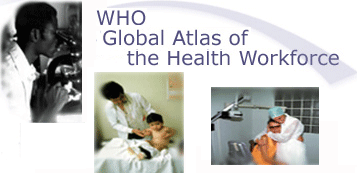Resource Spotlight: Global Atlas of the Health Workforce

There is a growing need for high quality information on human resources in health systems to inform decision making for policies and programs at the national and international levels. The World Health Organization (WHO) Department of Human Resources for Health has been collecting and compiling cross-nationally comparable data on health workers in all WHO Member States. The data available in the Global Atlas of the Health Workforce database is the main outcome of this effort.
Estimates of the stock (absolute numbers) and density (per 1000 population) of the health workforce are available here for 193 Member States. National-level data refer to the active health workforce, that is, all persons currently participating in the health labor market. Counting health workers poses challenges, including how to define them. The World Health Report 2006 defines health workers as "all people engaged in actions whose primary intent is to enhance health." Various permutations and combinations of what constitutes the health workforce potentially exist depending of each country's situation and the means of measurement. The information presented here reflects a framework for harmonizing the boundaries and constituency of the health workforce across contexts.
Two sets of data are contained in the Global Atlas: a main (aggregated) set and a disaggregated set. The aggregated dataset includes estimates of the stock and density of health workers for up to 9 occupational categories. This includes: (i) physicians; (ii) nursing and midwifery personnel; (iii) dentistry personnel; (iv) pharmaceutical personnel; (v) laboratory health workers; (vi) environmental and public health workers; (vii) community and traditional health workers; (viii) other health service providers; and (ix) health management and support workers, that is, those who do not provide services directly but are critical to the performance of health systems. In the disaggregated dataset, estimates of the stock of health workers are available for some countries for up to 18 occupational categories, reflecting greater distinction of some categories of workers according to assumed differences in skill level and skill specialization. [publisher’s description]
View this resource.
The HRH Global Resource Center has other resources on this topic including:
- Health Systems Database
- Health Workforce Statistics: Data Sources and Quality
- New Database of Health Professional Emigration from Africa
For additional resources on this topic, visit the Workforce Assessment subject category or the Data & Statistics resource type.
Past Resource Spotlights
- 5590 reads




